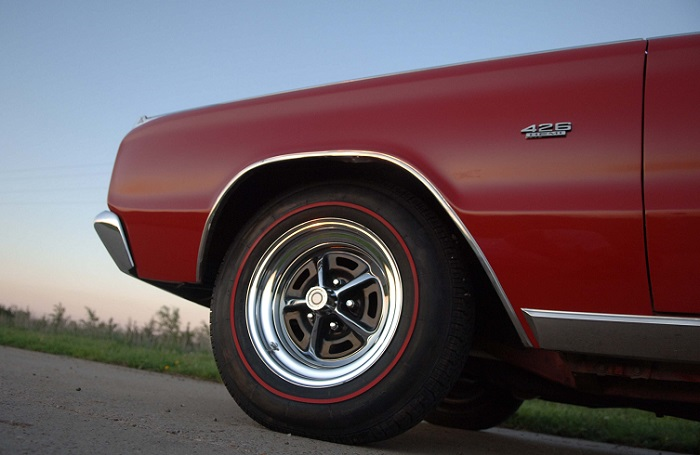As we stated in Part One of this article, car enthusiasts have a special lingo all their own. In Part Two of this article, you may several of these terms familiar but a few may be new to you.
Dog Dish
“Dog dish” is a common term for the simple base-model hubcaps back in the day. They were typically made of pressed aluminum and looked like, well, dog dishes.
DOHC
“Double Overhead Camshaft” describes the construction of the valve train in some engines. Most engines had a camshaft in the center of its block, like the famous small-block Chevrolet V8. However, some manufacturers created DOHC layouts to enhance performance and revving capacity. This engine configuration was rare in the classic muscle car years.
Dual Quad
High performance engines need lots of air so to achieve that many engineers used multiple carburetors. One of the most popular among the performance set is the dual quad. This means that a car’s intake system consists of two four-barrel carburetors. This meant that each cylinder in a V8 was being fed by its own carburetor barrel. Dual quad engines were powerful, and used a lot of gasoline.
Eight-Lug
During the 1960s, Pontiac introduced a special eight-lug wheel pattern on their full-size models. The Pontiac wheels made from 1960 to 1968 were special and today, this is a highly sought-after option.
Four-Bolt Main
The term “four-bolt main” refers to engine construction where they connect the crankshaft’s main bearing cap with four bolts to the engine block. Standard duty engines only need 2 bolts in each bearing cap but they can fail during high RPM. That’s why engines for high revving and maximum performance have four-bolt main bearing caps.
Glasspack
Glasspack mufflers are special mufflers designed for easy air flow through the exhaust system. They are called glasspacks because instead of complex internal muffler baffles, they have a simple glass-fiber lining inside. The problem with glasspacks is that they are noisy which is why Detroit never used them.
HEMI
Hemi engines have hemispherical (dome-shaped) combustion chambers. Such a solution wasn’t new in the car industry but, in the early 1950s, Chrysler managed to perfect it. While Chrysler made small displacement Hemis, Neuwirth Motors (Wilmington, NC) Motors told us that in 1966 they released the mighty 426 Hemi. It featured a big four-barrel carburetor with a lower 10.5:1 compression ratio and produced 425 HP. The Hemi package was available on select Dodge and Plymouth models but it was expensive at $900 to $1,200, which was around a third of the price of the car!
High-Rise
The High-Rise or High-Riser is a type of aftermarket intake manifold they designed to make air travel longer. And doing that adds a ram effect and provides more torque as well. This was a common modification for serious street racing cars back in the ’60s and early ’70s.
Magnum 500
One of the most popular wheel choices in the muscle car era was the beautiful Magnum 500 wheels they introduced in late 1963. Made under license by the British firm of Rubery Owen, the magnum 500 wheels had a characteristic pressed steel design form with raised ‘spokes’, and were painted aluminium-grey on the spokes and rim and black between the spokes to imitate the open space of true magnesium wheels. The Magnum 500 was a common factory option on almost all Detroit muscle cars. Interestingly, only one company refused to install them on their muscle cars. Pontiac never came with the Magnum 500, but had their own version they had named Rally II.
Matching Numbers
The phrase “matching numbers,” means the engine, gearbox, and drivetrain are original to the car and the individual production codes can be verified. Matching numbers cars are prized by collector car people due to their authenticity and, as a result, they command higher prices than cars with replaced drivetrain components.
Want more gearhead terms? Head on over to Part Three!


Comments are closed.